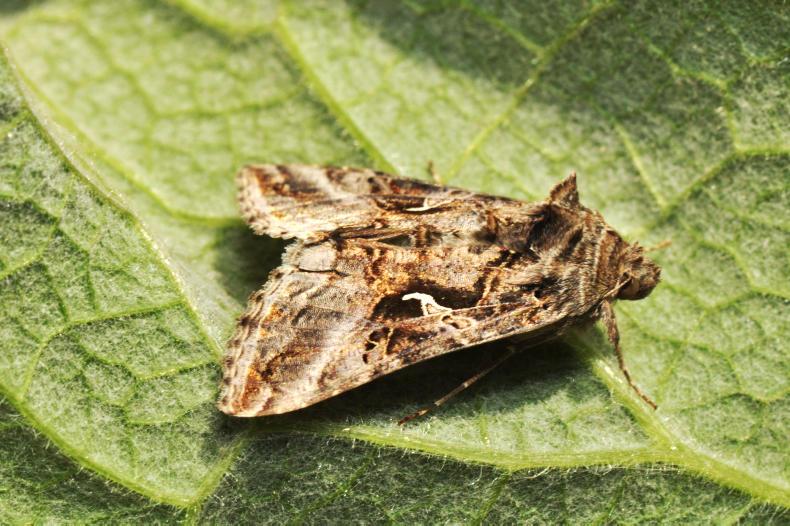Over the past 10 days, many growers have experienced the worst pest attack on their fodder and sugar beet crops in many years. Growers have reported an explosion of suspected silver Y moth (Autographa gamma) larvae in beet crops around the country. First sightings of the pest were noted three weeks ago when pin holes formed in beet canopies in parts of the south. Since then, increasing pest populations have caused substantial leave damage to affected areas. Reports of pest damage are now coming from almost every corner of the country.
Leaf damage
Silver Y moth larvae (caterpillars) feed on plant foliage. In some cases leaf damage has been minor, but in others over 70% of the green leaf area of infected leaves has been lost. The larvae tend to feed on low-lying vegetation including a range of horticulture crops. The caterpillars' droppings (frass) and the caterpillar themselves can contaminate fresh produce.
Identification
The silver Y moth caterpillar is distinguishable by having only having two sets of prolegs and a rear clasper. This causes it to walk with an arched body. It generally moves via a looping movement.
The colour and a number of other key anatomical features depend in the instar stage (developmental stage).
In early instars, the caterpillars are green with a series of white wavy lines and a slightly muddied green head.
In later instars the pale wavy dorsal lines are broken on each segment by small concentric pale and green circles centred on a small pale dot. The caterpillars can also form a much darker green dorsal line which is now commonly seen in many fields across the country.
Life cycle

Silver Y moth (Autographa gamma)
The silver Y moth is a common species to Ireland and is identified through a white/silver Y-shaped marking on its back.
The moth lays its eggs on the underside of leaves, which can hatch in as little as seven days.
The caterpillars have four instars and take around 30 days to pupate. During this time they gorge on the underside of the leaves, causing significant damage when present in high numbers. When fully grown, the larva pupates on a leaf within a loose web-like cocoon. From the time between an egg being laid and the adult moth emerging is about eight weeks.
Control
Growers are applying products containing either deltamethrin or lambda-cyhalothrin to varying degrees of success.
Read more
Crop areas juggled by late spring weather
How much animal feed do we import?
Over the past 10 days, many growers have experienced the worst pest attack on their fodder and sugar beet crops in many years. Growers have reported an explosion of suspected silver Y moth (Autographa gamma) larvae in beet crops around the country. First sightings of the pest were noted three weeks ago when pin holes formed in beet canopies in parts of the south. Since then, increasing pest populations have caused substantial leave damage to affected areas. Reports of pest damage are now coming from almost every corner of the country.
Leaf damage
Silver Y moth larvae (caterpillars) feed on plant foliage. In some cases leaf damage has been minor, but in others over 70% of the green leaf area of infected leaves has been lost. The larvae tend to feed on low-lying vegetation including a range of horticulture crops. The caterpillars' droppings (frass) and the caterpillar themselves can contaminate fresh produce.
Identification
The silver Y moth caterpillar is distinguishable by having only having two sets of prolegs and a rear clasper. This causes it to walk with an arched body. It generally moves via a looping movement.
The colour and a number of other key anatomical features depend in the instar stage (developmental stage).
In early instars, the caterpillars are green with a series of white wavy lines and a slightly muddied green head.
In later instars the pale wavy dorsal lines are broken on each segment by small concentric pale and green circles centred on a small pale dot. The caterpillars can also form a much darker green dorsal line which is now commonly seen in many fields across the country.
Life cycle

Silver Y moth (Autographa gamma)
The silver Y moth is a common species to Ireland and is identified through a white/silver Y-shaped marking on its back.
The moth lays its eggs on the underside of leaves, which can hatch in as little as seven days.
The caterpillars have four instars and take around 30 days to pupate. During this time they gorge on the underside of the leaves, causing significant damage when present in high numbers. When fully grown, the larva pupates on a leaf within a loose web-like cocoon. From the time between an egg being laid and the adult moth emerging is about eight weeks.
Control
Growers are applying products containing either deltamethrin or lambda-cyhalothrin to varying degrees of success.
Read more
Crop areas juggled by late spring weather
How much animal feed do we import?







 This is a subscriber-only article
This is a subscriber-only article















SHARING OPTIONS: